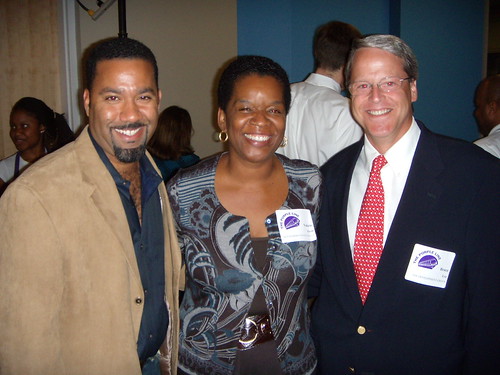 A new zoning amendment for the Fillmore could mean redevelopment might not take place on Colesville for fifteen years. For more, check out the Silver Spring Scene, who discussed the changes with County officials and developer Bruce Lee last month.
A new zoning amendment for the Fillmore could mean redevelopment might not take place on Colesville for fifteen years. For more, check out the Silver Spring Scene, who discussed the changes with County officials and developer Bruce Lee last month.For over twenty years, the block at the northeast corner of Georgia and Colesville has sat empty, save for a row of languishing shops and the landmark Lee Building, which opened in 1987 without a single tenant. Today, Montgomery County's got a plan to revitalize the block with its Fillmore music hall, set to occupy a former J.C. Penney on Colesville. How? By letting everything around it sit empty for even longer.
Over the past month, many have called foul on the proposal: a pair of zoning changes offered by County Executive Ike Leggett that would give the Lee Development Group, who owns most of the block, fifteen years to build it up - while also counting the new venue as a public space. But Diane Jones, Assistant Chief Administration Officer for the County, says it's a good way to ensure the community's needs are met while accommodating new development.
"[The amendment] provides a means for the County Executive to identify something as the public use space for a project." says Jones in a phone interview earlier this week with Just Up The Pike. "We've identified something in Silver Spring - a boarded-up storefront - that we'd like to see fixed-up."
Applying only to Arts and Entertainment Districts in downtowns Wheaton, Silver Spring and Bethesda - the proposed changes allow Montgomery County to set their terms for how public uses should work, but give developers room to build as they need. In older downtowns where the land is divided up into small, separately owned properties, it's hard to make a difference "short of creating an urban renewal area," Jones explains.
so much more AFTER THE JUMP . . .
 The former J.C. Penney building - soon to be the Fillmore - shown in September 2007.
The former J.C. Penney building - soon to be the Fillmore - shown in September 2007.Last month, Silver Spring, Singular complained that the new regulations would allow Lee Development Group to "essentially remain a slumlord" in the area, but Jones says there's only so much the County can do. "Do you think we have the ablilty to force somebody to develop?" she asks. "I would encourage you to think about this as a multi-phase project . . . and multi-phase projects get a lot of extensions. It's pretty routine."
Most large developments in Montgomery County are required to provide a public space, typically a pocket park or plaza. In multi-phase projects, it doesn't get built until enough revenue is raised to pay for it, usually after "ten or twelve years," says Jones. With the new changes, not only does the public space get built first, but the County gains several years of appreciation that otherwise wouldn't have happened on a property estimated to be worth $6 million. "We're getting it for free now, instead of in the out years," she notes. "That advanced use has a value associated with it."
 Developer Bruce Lee (at left) with County Councilmember Val Ervin (middle), a supporter of the Fillmore, and musician Marcus Johnson at a fundraiser last fall.
Developer Bruce Lee (at left) with County Councilmember Val Ervin (middle), a supporter of the Fillmore, and musician Marcus Johnson at a fundraiser last fall.From Jones's perspective, it's a huge leap of faith for the Lees, having been "burned" in the past. "I know they built the Lee Building as a speculative building at a time when the economic cycle was down and it failed," she says. "They are not speculative developers [anymore] . . . if they had a project, they would go forward."
"They part with the flexibility with what they can do with their land," Jones adds. "When they do their detail design, they have to design around what they've already given up . . . they'll have to pay for traffic studies; they'll have to pay a site planner to do massing for their ultimate project. And that's not cheap . . . giving them extensions for their land for this amenity space seems fair."
Planning Board chairman Royce Hanson, who soundly rejected the proposal at a hearing last month, points to the Silver Triangle - a giant shopping mall conceived by Lee in 1990 that would have bridged over Georgia Avenue - as an example of the developer's "unreasonable" demands. But his recommendations may not have a bearing on the final decision.
"The actual decision makers for this are the county council, and they've already had their public hearing," says Jones. Over the next month, the County Council's Planning, Housing and Economic Development Committee will discuss the amendments in a worksession, with a vote before the whole council to take place sometime in September.
The recent controversy has been a distraction, Jones says, from the real goals of the music hall project, which first began in 2001. "When we have something that could provide an enriching and cultural public space, I wonder why we shouldn't do that," she laments. "Putting politics aside, it's something that should be done, not a political issue: How we get an old storefront reenergized."

No comments:
Post a Comment